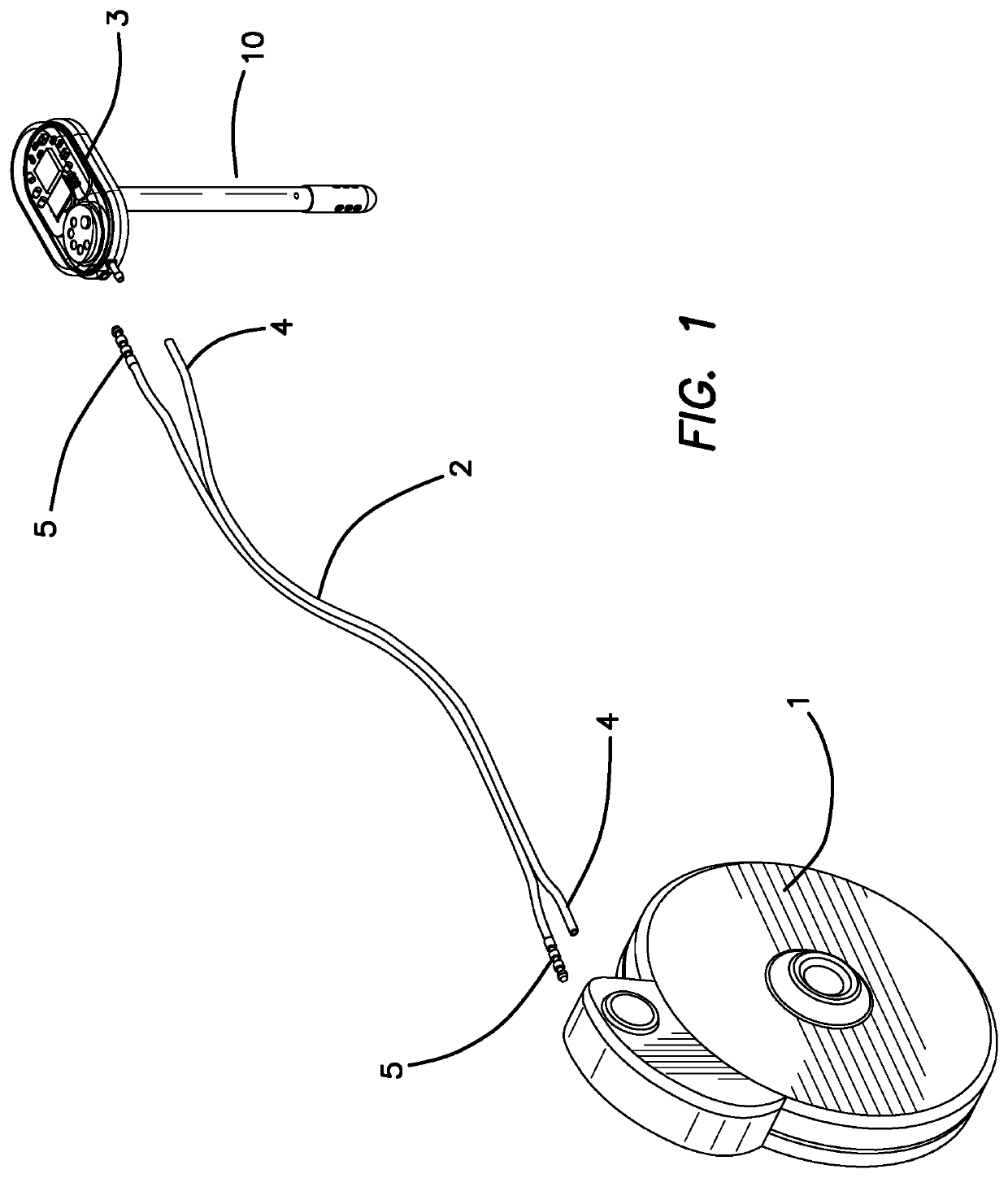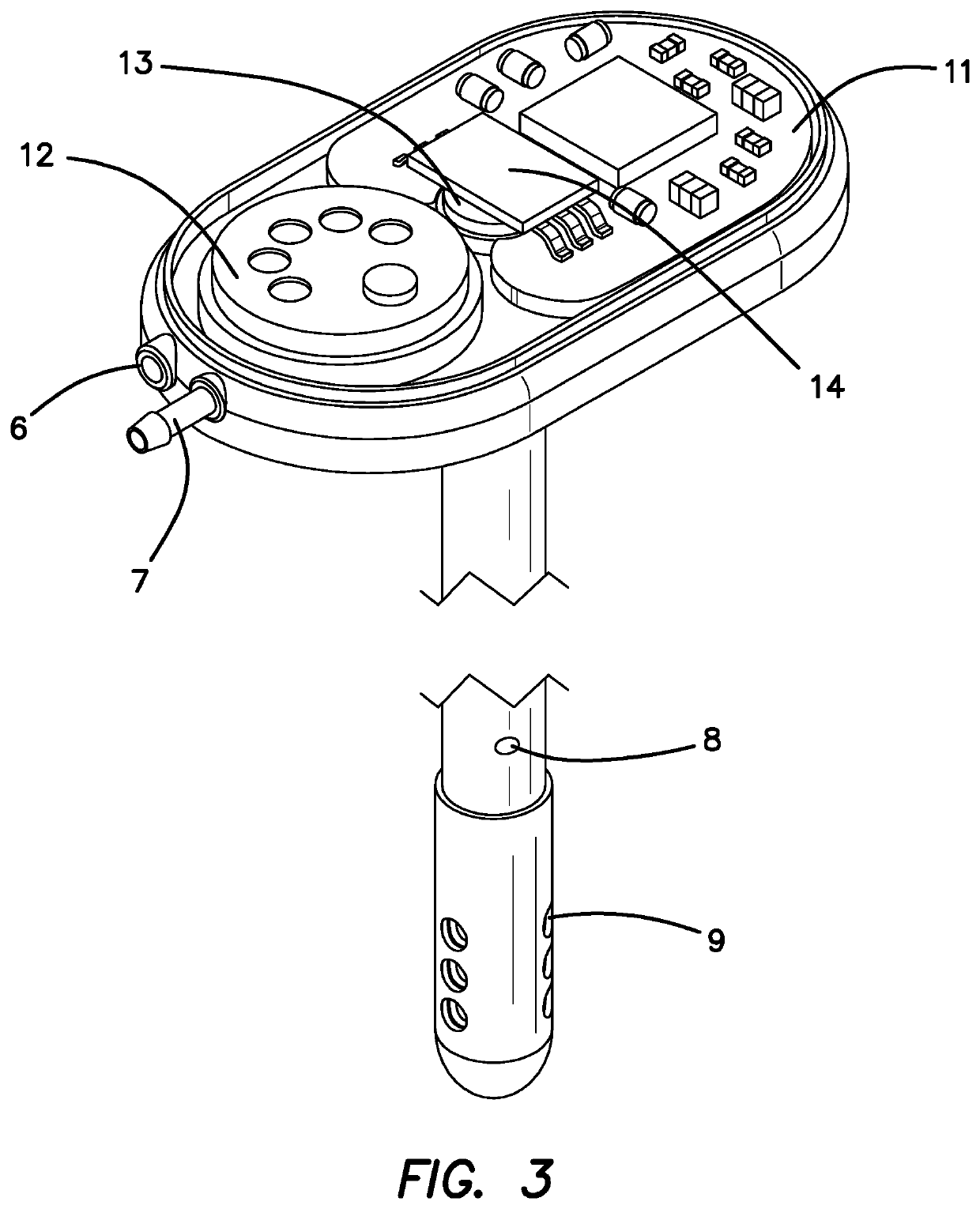Skull-Mounted Drug and Pressure Sensor
a pressure sensor and ommaya technology, applied in the field of implantable pumps, can solve problems such as improper drug delivery, catheter lesions, and infections of the ommaya reservoir, and achieve the effects of improving the safety and safety of patients, reducing the risk of infection, and improving the safety of patients
- Summary
- Abstract
- Description
- Claims
- Application Information
AI Technical Summary
Benefits of technology
Problems solved by technology
Method used
Image
Examples
fourth embodiment
[0038]FIG. 1 illustrates perspective view of the ISP 1, the SOS 3, a ventricular catheter 10 for insertion into the brain and a dual lumen drug supply catheter 2 which connects the pump 1 to the SOS 3. The dual lumen catheter includes one lumen 4 for drug delivery and a second lumen 5 for the wires necessary for bidirectional communication between the SOS 3 and the pump 1. The drug delivery catheter lumen 4 connects to the SOS through port 7 and the electronics wires 5 connect via pass through port 6 as illustrated in FIG. 2. A drug or multiple drugs will be provided through catheter lumen 4 coming from an implantable pump 1 or an external pump (not shown) through a pump reservoir (not shown), or through the ventricular access port 30 in the fourth embodiment in FIGS. 15-16, and thence via ventricular catheter 10 into the ventricle emanating from the drug delivery port 8. The CSF / drug sensing chamber 21 shown in FIG. 6 is in fluid communication with the CSF via holes 9 in FIG. 2. Th...
first embodiment
[0042]FIG. 8 is a block diagram of the power, communication and fluid systems for the ISP 1, catheter system and the SOS in the The ISP 1 and SOS 3 illustrated here have distinct functions. The SOS 3 is designed to provide the essential functions for optical sensing and capturing the sensed information. It also houses the drug-delivery channel 22. The ISP 1 is the source of the drug, the wireless communication system, the drug pump, the power, the main computing and analysis electronics and the software. The diagram labels the main components of the ISP 1, the catheter 2, ventricular catheter 10 and the SOS 3. The wired connector in catheter 2 is connected to the electrical connector tips 4 in FIG. 1 on each end the fluid path in catheter 2 illustrated with a white line. The clear line is the drug delivery lumen 4 which is connected to the ISP and through connector 7 to the SOS 3. The dotted lines around the ISP 1 and SOS 3 illustrate the perimeter of each device. ISP 1 includes a ...
third embodiment
[0054]The embedded micro-controller and Bluetooth controller 52 in the third embodiment provide the bidirectional data communication, data measurement schedule and data storage. The internal button lithium battery 54 provides the necessary operating power. To conserve energy, the electronics hardware 50, 52 will spend the majority of the time in “sleep mode”.
[0055]Since the absorption spectra of most drugs features at least one prominent peak, the UV / VIS LEDs frequencies can be selected to cover optionally one or more leading edges of selected peaks one or more major peak maxima, optionally one or more trailing peak edges and a neutral reference—where absorption does not change with drug concentration—over the drug specific frequencies range.
[0056]The optical sensor has one or more LEDs depending on the requirements of a predetermined analysis complexity. For more flexibility and for general applications the number of LEDs can be increased to cover a wider range of wavelengths and s...
PUM
 Login to View More
Login to View More Abstract
Description
Claims
Application Information
 Login to View More
Login to View More - R&D
- Intellectual Property
- Life Sciences
- Materials
- Tech Scout
- Unparalleled Data Quality
- Higher Quality Content
- 60% Fewer Hallucinations
Browse by: Latest US Patents, China's latest patents, Technical Efficacy Thesaurus, Application Domain, Technology Topic, Popular Technical Reports.
© 2025 PatSnap. All rights reserved.Legal|Privacy policy|Modern Slavery Act Transparency Statement|Sitemap|About US| Contact US: help@patsnap.com



